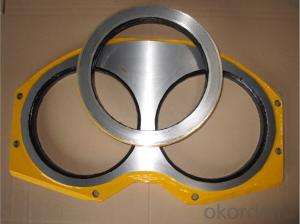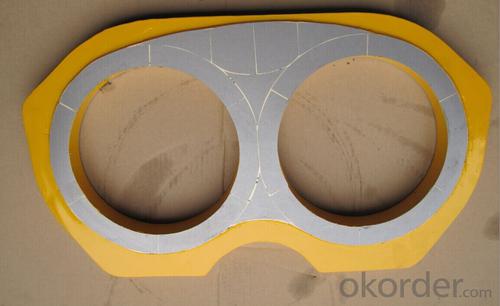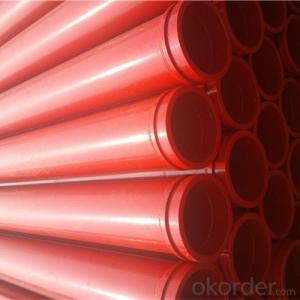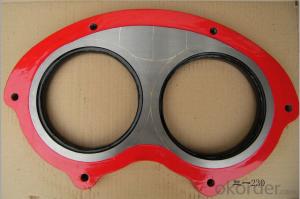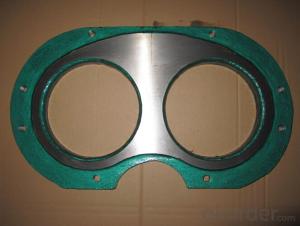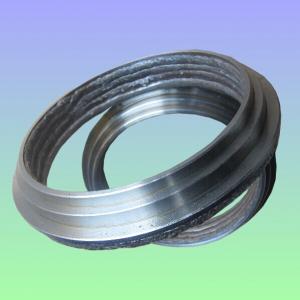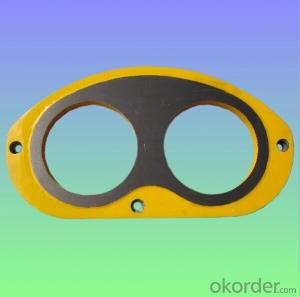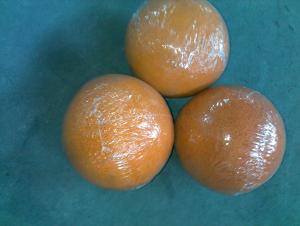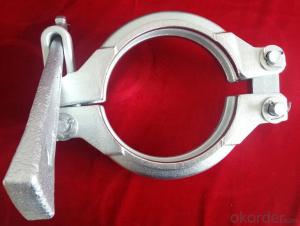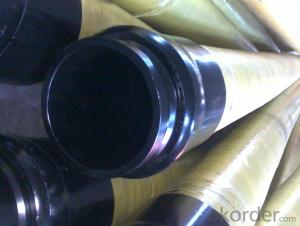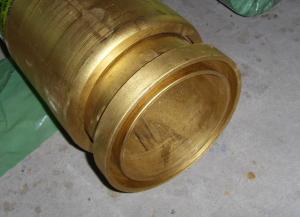Putzmeister Spectacle Wear Plate and cutting Ring DN200
- Loading Port:
- Tianjin
- Payment Terms:
- TT or LC
- Min Order Qty:
- 3 pc
- Supply Capability:
- 1000 pc/month
OKorder Service Pledge
OKorder Financial Service
You Might Also Like
Product Name: Putzmeister Spectacle Wear Plate and cutting Ring DN200
1. Specification
1. Material: Plate body S35C steel, tungsten carbide E5 grade ,
2. Lifetime: 30,000~80,000cbm
3. HRA≥86
4. Germany Welding rod used for hardfacing
5. tensile strength ≥ 2500 N/mm2
6. Application: trailer and trunk mounted Putzmeister concrete pump
Notes: total series of Concrete Pump Spectacle Wear Plate and Cutting Ring for different brand concrete pump (PUTZMEISTER, SCHWING, CIFA, SANY, ZOOMLION, IHI, KYOKUTO,Niigata Etc) available from us.
2. Application
Our Putzmeister Spectacle Wear Plate and cutting Ring DN200 have been successfully exported to many countries from 1998, Our main markets as below: Middle East, Southeast Asia, America, Brazil, Italy, Russia, South Africa etc
3. Package
Every 60pcs Tungsten Carbide Putzmeister Spectacle Wear Plate and cutting Ring DN200 put in one seaworthy wooden box, and 20 boxes in one 20feet container.
FAQ:
Q1: Why buy Materials & Equipment from us?
A1: All products have its ISO certifications, adheres to the highest standards and a commitment to supply chain safety and customer satisfaction.
Q2: How do we guarantee the quality of our products?
A2: We have established an advanced quality management system which conducts strict quality tests at every step, from raw materials to the final product. At the same time, we provide extensive follow-up service assurances as required.
Q3: How soon can we receive the product after purchase?
A3: Within three days of placing an order, we will begin production. The specific shipping date is dependent upon international and government factors, but is typically 10 to 30 workdays.
Q4: If we can produce some Tungsten Carbide Putzmeister Spectacle Wear Plate and cutting Ring DN200 according to customers request?
A4: Yes, we can produce Putzmeister Spectacle Wear Plate and cutting Ring DN200 according to the difference country situations and different concrete pump to make it suitable to the market and customers. We have very professional technical team to make the design.
Q5: How to make a quick resolution for after service?
A5:We have overseas branches all-around of world, IF needed, the seller shall dispatch 2 engineers to the buyer's site for supervision of training. The buyer shall make available of necessary facilities &skilled personnel at site for training.
Images:
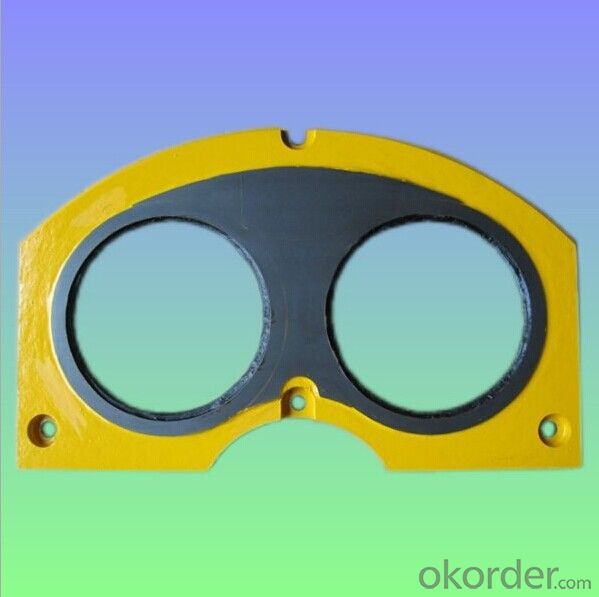
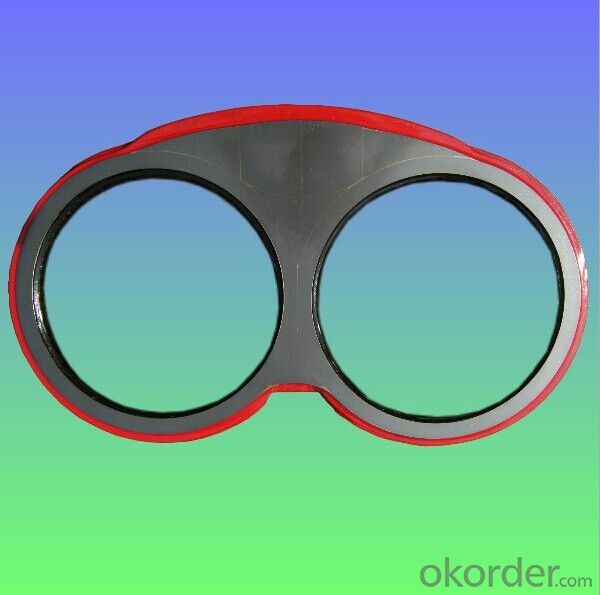
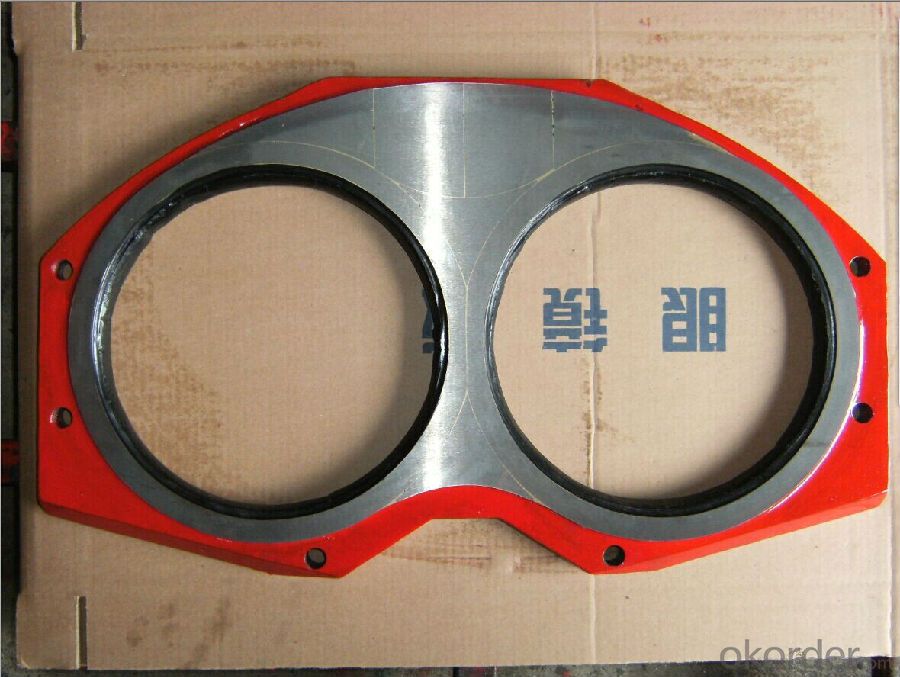
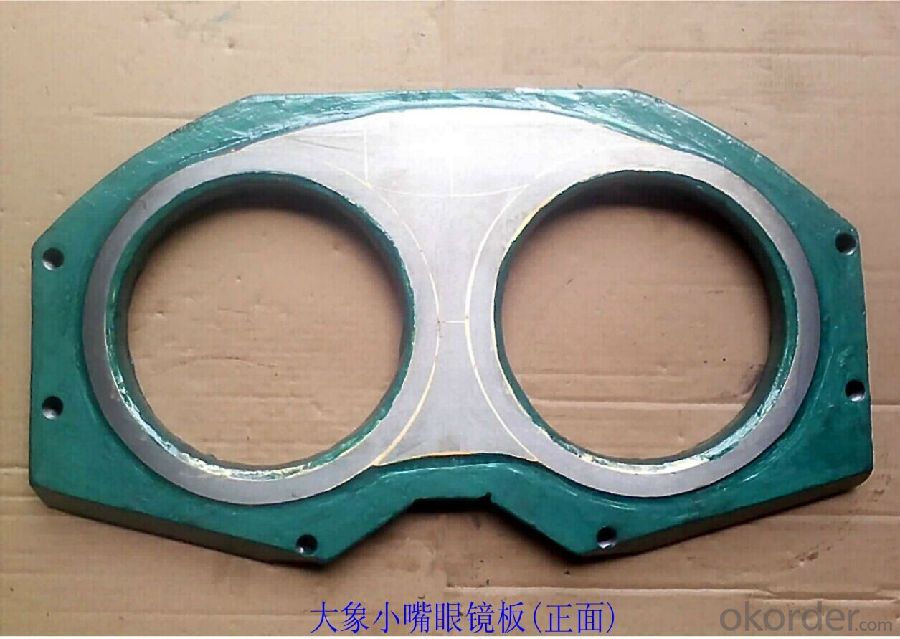
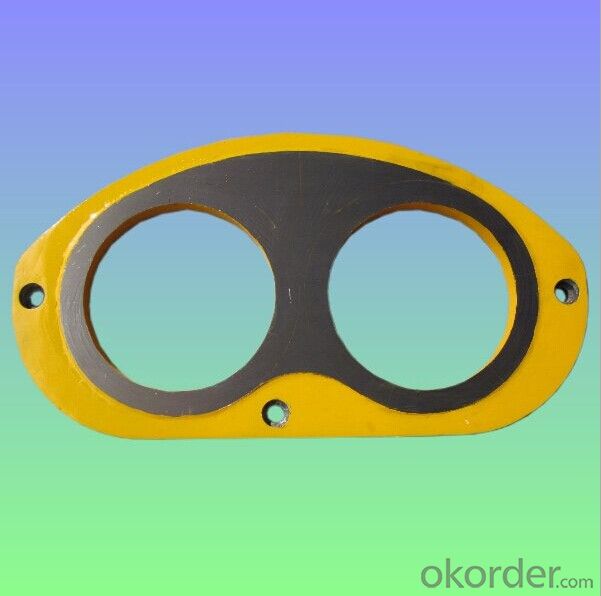
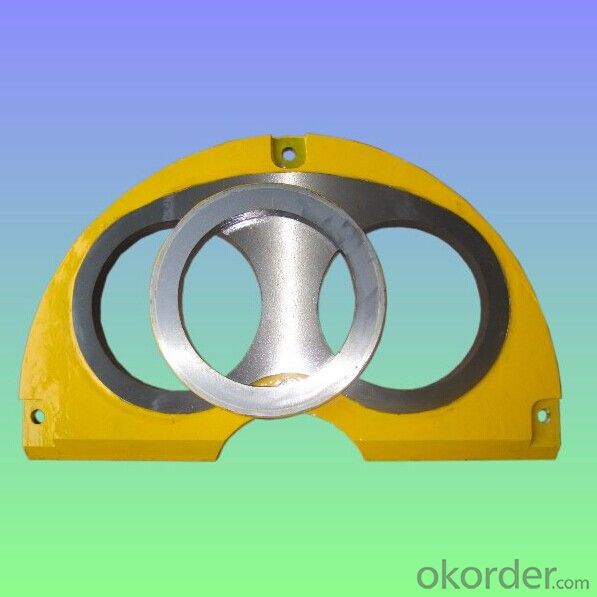
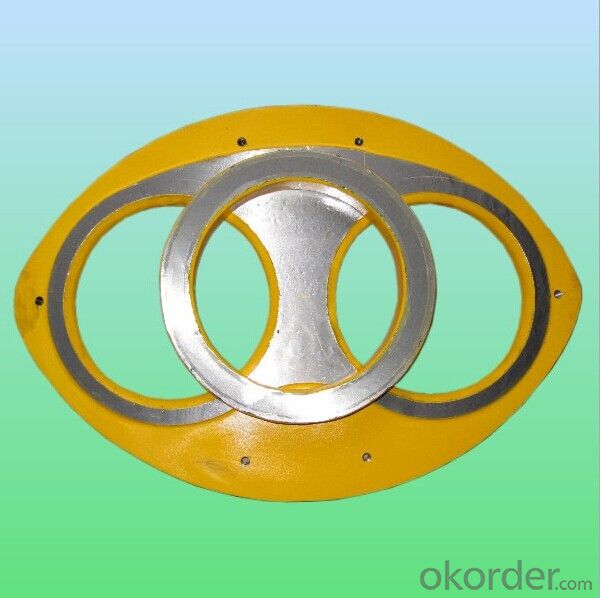
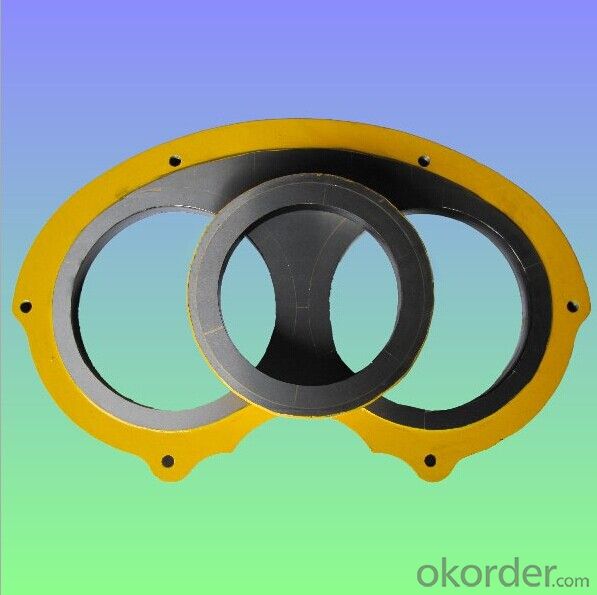
- Q: Can I get spare parts for both concrete pumps with and without emergency stop systems?
- Yes, you can get spare parts for both concrete pumps with and without emergency stop systems. Most manufacturers and suppliers of concrete pumps offer a wide range of spare parts that are compatible with various models and types of pumps. These spare parts include components like hoses, pipes, valves, seals, and other essential parts that may need replacement due to wear and tear or damage. Whether your concrete pump has an emergency stop system or not, you should be able to find the necessary spare parts to keep your pump running smoothly. However, it is important to note that the availability of specific spare parts may vary depending on the brand, model, and age of your concrete pump. To ensure you get the right spare parts, it is advisable to consult the manufacturer or supplier of your concrete pump. They can provide you with a comprehensive list of spare parts and guide you in selecting the appropriate ones for your specific pump. Additionally, they may also be able to assist you with any technical support or troubleshooting related to your concrete pump.
- Q: Can I get spare parts for both concrete pumps with and without pressure washers?
- Spare parts for both concrete pumps with and without pressure washers are readily available. Numerous manufacturers and suppliers offer an extensive selection of spare parts for concrete pumps, even those equipped with pressure washers. These spare parts consist of various components, including hoses, nozzles, valves, cylinders, seals, filters, and other necessary accessories for proper concrete pump operation. It is crucial to maintain and promptly replace worn-out or damaged parts to guarantee optimal performance and long-lasting equipment, regardless of whether your concrete pump has a pressure washer or not.
- Q: How can a malfunctioning hydraulic motor affect the pumping process?
- Various negative effects can occur in the pumping process due to a hydraulic motor malfunction. Firstly, there may be a decrease in pumping efficiency. The hydraulic motor is responsible for converting hydraulic energy into mechanical energy, which drives the pumping mechanism. If the motor is not functioning properly, it may not generate enough power to operate the pumping system effectively, resulting in a decrease in the volume or pressure of the pumped fluid. Moreover, an increase in energy consumption can be caused by a faulty hydraulic motor. Inefficient or faulty motor operation can lead to higher energy requirements to maintain the desired pumping rate. This increased energy consumption can result in higher operating costs and reduced overall system performance. Furthermore, irregular pumping or complete pump failure can occur as a result of a malfunctioning hydraulic motor. If the motor is not operating correctly, it may cause intermittent or inconsistent pumping, leading to fluctuations in the flow rate or pressure of the pumped fluid. In extreme cases, the motor may stop working entirely, resulting in a total loss of pumping functionality. Additionally, the entire pumping system may experience increased wear and tear due to a malfunctioning hydraulic motor. Improper motor operation can create excessive vibration or heat, leading to premature failure of other components such as seals, bearings, or pistons. This can result in frequent maintenance or repair requirements, leading to increased downtime and costs. In summary, the pumping process can be significantly affected by a malfunctioning hydraulic motor. This includes decreased efficiency, increased energy consumption, irregular pumping or complete pump failure, and increased wear and tear on the system. It is essential to regularly inspect and maintain hydraulic motors to ensure proper functioning and avoid potential issues that may disrupt the pumping process.
- Q: How can a faulty concrete pump cylinder affect the pumping process?
- The pumping process can be significantly impacted by a faulty cylinder in the concrete pump. The cylinder's role is crucial in the concrete pumping system as it generates the necessary pressure to push the concrete through the pipes and hoses. A decrease in pumping efficiency is one of the main issues caused by a faulty cylinder. If the cylinder is worn out or damaged, it may not generate sufficient pressure to effectively push the concrete. This can lead to a decrease in the pumping rate and overall productivity of the concrete pumping operation. Moreover, a faulty cylinder can cause irregular and inconsistent flow of concrete. This can result in blockages or clogs in the pipes, disrupting the pumping process. Removing these blockages can be time-consuming and costly, as it may require disassembling the pumping system to access and clear the blocked area. Additionally, leaks can occur in the pumping system due to a faulty cylinder. These leaks not only waste concrete but also reduce the overall pressure in the system, impacting the ability to pump the concrete to the desired location. Furthermore, leaks can create a messy worksite, posing safety risks for workers and potentially damaging surrounding structures. Furthermore, the risk of equipment failure is increased by a faulty cylinder. If the cylinder malfunctions or fails completely, it can cause the entire pumping system to shut down. This can result in significant downtime and delays in the concrete pouring process, leading to additional costs and potential penalties. In conclusion, a faulty concrete pump cylinder can have a significant impact on the pumping process by reducing efficiency, causing irregular flow, promoting leaks, and increasing the risk of equipment failure. To ensure smooth and efficient concrete pumping operations, it is essential to regularly maintain, inspect, and replace the cylinder in a timely manner.
- Q: What are the indications of a faulty concrete pump hydraulic motor?
- There are several indications that can point to a faulty concrete pump hydraulic motor. Some common signs to look out for include: 1. Loss of power: If the hydraulic motor is not functioning properly, you may notice a significant loss of power in the concrete pump. The motor may struggle to generate enough force to pump the concrete effectively, resulting in slower or weaker output. 2. Excessive noise or vibrations: A faulty hydraulic motor may produce unusual noises or vibrations during operation. This could be a result of damaged internal components or misalignment, indicating a problem with the motor. 3. Fluid leaks: Hydraulic motors rely on the proper flow and pressure of hydraulic fluid to function correctly. If you notice any fluid leaks around the hydraulic motor or its associated components, it could be a sign of a faulty motor that needs attention. 4. Overheating: When a hydraulic motor is faulty, it may overheat due to increased friction or internal malfunctions. If you notice excessive heat coming from the motor or associated components, it is essential to address the issue promptly to avoid further damage. 5. Inconsistent or jerky movement: A faulty hydraulic motor may cause the concrete pump to operate inconsistently or jerkily. This can result in uneven pouring or difficulty in controlling the flow of concrete, indicating a problem with the motor's performance. 6. Increased energy consumption: If the hydraulic motor is faulty, it may require more energy to operate properly. This can lead to a noticeable increase in energy consumption, which can be observed through higher electricity bills or a greater strain on other parts of the pump's system. It is important to note that these indications may vary depending on the specific make and model of the concrete pump hydraulic motor. It is always recommended to consult the manufacturer's guidelines or seek professional assistance to diagnose and address any issues with the hydraulic motor effectively.
- Q: How to calculate the power of concrete pump motor?
- Of course, the motor power is large, the transmission speed is fast
- Q: What is the role of a concrete pump hopper agitator shaft?
- To ensure consistent and uniform mixing of concrete in the hopper, the concrete pump hopper agitator shaft is responsible. It is equipped with paddles or blades that rotate within the hopper, effectively stirring the concrete and preventing it from settling or separating. This maintains the desired fluidity and consistency of the concrete, allowing for smooth and efficient pumping without any blockages. Additionally, the agitator shaft helps to remove any hardened or stuck concrete, ensuring that the hopper remains clean and obstruction-free. Ultimately, the agitator shaft plays a vital role in keeping the concrete well-mixed and ready for pumping, thereby improving the performance and productivity of the concrete pump.
- Q: How do I properly maintain and replace wear plates in concrete pump spare parts?
- Proper maintenance and replacement of wear plates in concrete pump spare parts involves regular inspection, cleaning, and timely replacement. Firstly, inspect the wear plates regularly for any signs of wear, cracks, or damage. Clean them thoroughly to remove any debris or hardened concrete buildup. If the wear plates are worn out or damaged beyond repair, they should be replaced immediately to ensure optimal performance and prevent further damage to the pump. It is crucial to use high-quality replacement wear plates that are specifically designed for your concrete pump model. Following the manufacturer's guidelines and seeking professional assistance when needed will help ensure the proper maintenance and replacement of wear plates in concrete pump spare parts.
- Q: How can a malfunctioning control panel affect the pump's operation?
- A malfunctioning control panel can affect the pump's operation by causing errors in controlling the pump's speed, pressure, or flow rate. It can also lead to inaccurate monitoring of the pump's performance, failure to detect faults or abnormalities, and difficulty in troubleshooting issues. Ultimately, a malfunctioning control panel can compromise the pump's efficiency, reliability, and overall functionality.
- Q: What are the indications of an inaccurate concrete pump pressure gauge?
- There are multiple signs that may suggest an unreliable concrete pump pressure gauge. Below are a few examples: 1. Inconsistent measurements: If the pressure gauge consistently provides varying readings despite consistent concrete pumping conditions, it could indicate an inaccurate gauge. For instance, if the gauge shows a pressure of 1000 psi one moment and then suddenly jumps to 1500 psi without any significant changes in the pumping operation, it could suggest a problem with the gauge. 2. Abnormal readings: If the pressure gauge consistently displays excessively high or low pressure readings that deviate significantly from the expected values, it may imply an inaccurate gauge. It is crucial to be aware of the usual pressure range for the specific concrete pumping operation to identify abnormal readings. 3. Incompatibility with other gauges: If there are multiple pressure gauges installed in the concrete pumping system and they provide notably different readings, it may indicate that one or more of the gauges are inaccurate. By comparing the readings from various gauges, it is possible to determine if a particular gauge is faulty. 4. Insufficient pump performance: If the concrete pump is not performing as anticipated, such as experiencing reduced output or inconsistent flow rates, it may be a result of inaccurate pressure readings. Inaccurate pressure measurements can disrupt the control of the pump's hydraulic system, leading to inefficiencies in pumping operations. 5. Physical damage or wear: Any visible damage or signs of wear on the pressure gauge, such as cracked glass, bent needles, or loose connections, can compromise its accuracy. Such physical damage can result in inaccurate readings and should be promptly addressed. Regular calibration and maintenance of the pressure gauge are essential to ensure accurate readings. If any indications of an inaccurate gauge are observed, it is advisable to consult a professional technician or engineer to assess the situation and take appropriate actions to rectify the issue.
Send your message to us
Putzmeister Spectacle Wear Plate and cutting Ring DN200
- Loading Port:
- Tianjin
- Payment Terms:
- TT or LC
- Min Order Qty:
- 3 pc
- Supply Capability:
- 1000 pc/month
OKorder Service Pledge
OKorder Financial Service
Similar products
Hot products
Hot Searches
Related keywords



